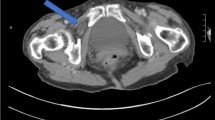Abstract
Background
Parastomal hernia with a reported incidence of up to 50% is a major problem after ostomy formation. Hernias at the closure site may be a problem after the closure of the enterostomy. In this study, in addition to physical examination, we used ultrasonography (USG) in order to find the true incidence of ostomy closure site and laparotomy incisional hernias.
Methods
We examined patients with closed enterostomy sites by both physical examination and USG for the detection of hernias. Risk factors for hernia formation, such as age, gender, body mass index (BMI), ostomy type, and surgical site infections, were determined.
Results
The evaluation of 31 patients with ostomies resulted in a 32% incidence of closed ostomy site hernias when patient medical history, physical examination, and ultrasonographic examination were used together. With physical examination and USG, incisional hernias at the laparotomy incision were found in 58% of cases. USG was able to detect hernias which were not clinically evident at the ostomy closure site and the laparotomy wound. BMI, age, gender, ostomy type, and surgical site infection did not have a significant effect on hernia formation.
Conclusion
Ostomy closure site and laparotomy incisional hernias are important clinical problems with a high incidence after ostomies are closed. Closure of the enterostomy site should be regarded as a hernia repair rather than a simple fascial closure. USG is a valuable clinical tool in combination with physical examination for the detection of minor defects.
Similar content being viewed by others
References
Hoffman MS, Barton DPJ, Gates J, Roberts WS, Fiorica JV, Finan MA, Cavanagh D (1992) Complications of colostomy performed on gynecologic cancer patients. Gynecol Oncol 44:231–234
Jänes A, Cengiz Y, Israelsson LA (2004) Preventing parastomal hernia with a prosthetic mesh. Arch Surg 139:1356–1358
Londono-Schimmer EE, Leong AP, Phillips RK (1994) Life table analysis of stomal complications following colostomy. Dis Colon Rectum 37:916–920
Cingi A, Cakir T, Sever A, Aktan AO (2006) Enterostomy site hernias: a clinical and computerized tomographic evaluation. Dis Colon Rectum 49:1559–1563
Parks SE, Hastings PR (1985) Complications of colostomy closure. Am J Surg 149:672–675
Berne JD, Velmahos GC, Chan LS, Asensio JA, Demetriades D (1998) The high morbidity of colostomy closure after trauma: further support for the primary repair of colon injuries. Surgery 123:157–164
Wong KS, Remzi FH, Gorgun E, Arrigain S, Church JM, Preen M, Fazio VW (2005) Loop ileostomy closure after restorative proctocolectomy: outcome in 1,504 patients. Dis Colon Rectum 48:243–250
van de Pavoordt HDWM, Fazio VW, Jagelman DG, Lavery IC, Weakley FL (1987) The outcome of loop ileostomy closure in 293 cases. Int J Colorectal Dis 2:214–217
Jamadar DA, Jacobson JA, Moraq Y, Girish G, Dong Q, Al-Hawary M, Franz MG (2007) Characteristic locations of inguinal region and anterior abdominal wall hernias: sonographic appearances and identification of clinical pitfalls. AJR Am J Roentgenol 188:1356–1364
Thomson JP, Hawley PR (1972) Results of closure of loop transverse colostomies. Br Med J 3:459–462
Porter JA, Salvati EP, Rubin RJ, Eisenstat TE (1989) Complications of colostomies. Dis Colon Rectum 32:299–303
Hesselink VJ, Luijendijk RW, de Wilt JH, Heide R, Jeekel J (1993) An evaluation of risk factors in incisional hernia recurrence. Surg Gynecol Obstet 176:228–234
van der Linden FT, van Vroonhoven TJ (1998) Long-term results after surgical correction of incisional hernia. Neth J Surg 40:127–129
Carne PW, Robertson GM, Frizelle FA (2003) Parastomal hernia. Br J Surg 90:784–793
Ballas KD, Rafailidis SF, Marakis GN, Pavlidis TE, Sakadamis AK (2006) Intraperitoneal ePTFE mesh repair of parastomal hernias. Hernia 10:350–353
Marimuthu K, Vijayasekar C, Ghosh D, Mathew G (2006) Prevention of parastomal hernia using preperitoneal mesh: a prospective observational study. Colorectal Dis 8:672–675
Israelsson LA (2005) Preventing and treating parastomal hernia. World J Surg 29:1086–1089
Geisler DJ, Reilly JC, Vaughan SG, Glennon EJ, Kondylis PD (2003) Safety and outcome of use of nonabsorbable mesh for repair of fascial defects in the presence of open bowel. Dis Colon Rectum 46:1118–1123
Franz MG, Kuhn MA, Nguyen K, Wang X, Ko F, Wright TE, Robson MC (2001) Transforming growth factor beta(2) lowers the incidence of incisional hernias. J Surg Res 97:109–116
Dubay DA, Wang X, Kuhn MA, Robson MC, Franz MG (2004) The prevention of incisional hernia formation using a delayed-release polymer of basic fibroblast growth factor. Ann Surg 240:179–186
Rieger N, Moore J, Hewett P, Lee S, Stephens J (2004) Parastomal hernia repair. Colorectal Dis 6:203–205
Burger JW, Luijendijk RW, Hop WC, Halm JA, Verdaasdonk EG, Jeekel J (2004) Long-term follow-up of a randomized controlled trial of suture versus mesh repair of incisional hernia. Ann Surg 240:578–583
DuBay DA, Choi W, Urbanchek MG, Wang X, Adamson B, Dennis RG, Kuzon WM Jr, Franz MG (2007) Incisional herniation induces decreased abdominal wall compliance via oblique muscle atrophy and fibrosis. Ann Surg 245:140–146
Author information
Authors and Affiliations
Corresponding author
Rights and permissions
About this article
Cite this article
Cingi, A., Solmaz, A., Attaallah, W. et al. Enterostomy closure site hernias: a clinical and ultrasonographic evaluation. Hernia 12, 401–405 (2008). https://doi.org/10.1007/s10029-008-0355-3
Received:
Accepted:
Published:
Issue Date:
DOI: https://doi.org/10.1007/s10029-008-0355-3



